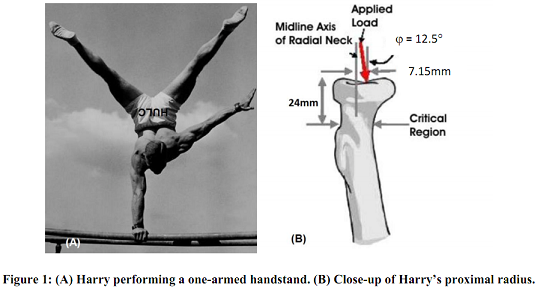Problem 1: Harry "The HULC" Henderson, a 25 year old, 65kg gymnast performs a one-armed handstand as shown in Figure 1A. This stunt obviously creates a stressful situation for the upper extremity joints, which are not accustomed to bearing the weight of the body. This stunt also involves impact, which increases the load by a factor of 3.4. The critical location for Harry is the neck of his radius shown in Figure 1B. At the elbow, the radius shares the load with the ulna, withstanding approximately 40% of the load through the elbow joint (Markholf et al., J Bone Joint Surg, 1998). Note that the radial head is eccentric relative to the neck of the radius, so that the applied load is offset from the midline of the critical area - the radial neck.

a) Calculate the tensile stress in the cortical bone, if the radial neck outer diameter is 4cm and the cortical bone thickness is 3.25mm. Determine if Harry will suffer a fracture of the radial neck using the yield stress as the failure criterion and assuming bone properties are the same in tension and compression.
b) Harry is now 70 years old (and weighs 79 kg) and to prove his gymnastic abilities to his grandchildren, decides to try the same trick. The radial neck outer diameter has shrunk to 3cm and his bone thickness is now 1.8mm. Determine Harry's risk of fracture given these new parameters (or if he will suffer a fracture now).
c) For an undisclosed amount of bonus points: explain why they call him "The HULC"?
Problem 2: You are working for a fracture-screening program that focuses on femoral diaphyseal fractures. Planar radiographs are taken of patients to calculate the hip joint reaction forces and to determine the dimensions of the cortex. The risk of fracture is then assessed using the criterion that the maximum strength of cortical bone is 126 MPa in tension and 190 MPa in compression.
a) Calculate the fracture risk for a 53 year old patient (64 kg) with a cranial-caudal (superior- inferior) joint force acting on the femoral head, parallel to the long axis of the femur, of 3.5 times body weight. Assume the load is the only hip joint reaction force and it acts 6.55 cm from the mid axis of the femur. The outer diameter of the femur is 42.5 mm with a cortical thickness of 8 mm. You may assume a circular cross-section and material properties gas given above. What is the patient's risk of suffering a fracture?
b) Additionally, you wish to calculate the patient's risk of fracture in the event of a slip-and- fall accident. To do this, you assume an anterior-posterior (not vertical as in part a) force of 5.66 times body weight will occur at 6.15 cm from the femoral axis. The critical location of stresses in the femur are at the mid-shaft location, 41.5 cm distal to the hip joint centre. Will a fracture of the femur occur as a result of the assumed loading condition (using a transverse tensile strength of 54 MPa)?
Problem 3: Please read "Bone properties of the humeral head and resistance to screw cutout" and write a maximum 2 page double spaced answer that discusses bone adaption in terms of Wolff's law, why trabecular and cortical bone may react differently to stimuli, and a summary of this paper and how it demonstrates these concepts. Please use examples and cite additional literature if required.
Our Musculoskeletal System Assignment Help tutors are well-versed with the guidelines and standard protocols of almost all the reputed colleges and universities and always write the paper accordingly.
Tags: Musculoskeletal System Assignment Help, Musculoskeletal System Homework Help, Musculoskeletal System Coursework, Musculoskeletal System Solved Assignments, Biomechanics Assignment Help, Biomechanics Homework Help